Help us to keep helping the collection to thrive. YOU can help bring more stories to life. Please, Give as You Live…

“Life is full or regrets, right? One of my greatest is that I didn’t realize all the questions I should have asked my grandfather before his death in 1965.
To be fair, he was 90 and in my 13-year-old mind it never occurred to me that he’d had a life before he was my grandfather. It wasn’t until 30 years later that my brother showed me the strangest hat inside I’d ever seen – a dark blue velvet cap with a tassel, an “S” design on the front and the numbers “1897-8” on the bill that had been given to him, the oldest son. It started us on a journey to find out what it was and why my grandfather had it.
There wasn’t much to go on: My mother, David’s daughter-in-law, remembered hearing stories about how he’d played rugby back in the old country, how they’d called him the “Flying Dai” and how he’d given football up to keep his mother happy after she found out they were going to be playing on Sunday … eventually the pieces started coming together: We learned how he’d played with some of the greatest names in the sport’s history … Billy Trew, Billy Bancroft, and the James brothers, Evan and David. My grandfather may never achieved legend status for himself, but how many could say they were on the field alongside those who did?
Sixty years have passed since his death, 20 years since we started researching our Welsh roots and still, I have questions. Thank you, Swansea RFC, for filling in some of the gaps.”
Marc Harris, Weirton, West Virginia, USA
10th January 2021.
Player profile: Dai Harries
DOB: 31 Oct. 1874 Llansamlet, Swansea.
DOD: 16 May 1965 Steubenville, Ohio, USA
Position: Outside-half
Clubs: Hamilton (Morriston), Swansea.
Swansea Record: 1896-97 to 1897-98. 1st XV: 3 matches, 2nd XV: 16 matches (4 tries).
Earliest confirmed match: 6th March 1897 2nd XV v Llanelli Moonlighters (home).
Final confirmed match: 28th March 1898 1st XV v Bristol (away).
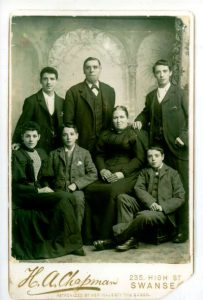
Born in Llansamlet on 31st October 1874 , D J (David, John) ‘Dai’ Harries (sometimes listed as Harris) was one of six children born to John and Mary (née Mort) Harries that survived to adulthood. Dai began his rugby career with the Hamilton Football Club in the Morriston district of the town. At this time both association and rugby clubs were called “Football” clubs regardless of which code they followed. The Hamilton FC was almost on his doorstep. Whether he progressed there from the Llansamlet club is not known. The Hamilton club was also a nursey for Welsh capped wings Willie Arnold and Fred Jowett (Jowett becoming Swansea’s first ‘Lion’ in 1904).
‘Flying Dai’ from Llansamlet.
Familiarly known in the family as ‘flying Dai’, Harries one of many young men working in the cauldron of the Plasmarl, Landore, Morriston area of heavy industry and playing football for district sides on the myriad small patches of ground where sports were allowed; a relief and distraction to the hard physical demands of the tin, copper and steel industries that cast a sooty gloom over the east side of the town. Dai was employed as a Tin House Riser, one of the many individual job names in tin-plate production.
Dai Harries came to Swansea Football Club toward the end of the 1896-97 season. This campaign had seen the beginning of an upturn in the fortunes of Swansea FC, with the return in February of the famous James brothers David and Evan, from 2 ½ years of suspension for professionalism. Their foray ‘up north’, drawn by the prospect of being paid to play brought upon them the wrath of the English and Welsh Rugby Unions. But their motivation to improve their situations was easily understandable to those they daily toiled with, including Dai Harries.
The ‘All Whites’ search for new half-backs.
As half-backs for Swansea and Wales, the James brothers had been the fulcrum of attacking play. The ‘All Whites’ had been Welsh Champions in 1889-90 and 1890-91 but had drifted in the doldrums in the absence of the James’s, known as the ‘Swansea Gems’ or the ‘Curley Haired Marmosets’. The hunt was now on for new half-backs, the James’s now being senior players and the ‘All Whites’ keen to ensure they passed the mantle on to a good half-back combination in due course. Dai Harries was one of several promising local half-backs. His first confirmed appearance was for the 2nd XV against the Llanelli Moonlighters in a match played at St Helen’s on 6th March 1897. The Moonlighters were an effective outfit, mainly consisting of miners (often entering the field straight from work, black faces and all). They virtually became Llanelli FC’s second fifteen the year that club dropped the official 2nds in 1898-99. The Swansea team captain this March afternoon at St Helen’s was Eddie Evans, Harris’ half-back partner and ‘first reserve’ half-back for the 1st XV. Swansea seconds beat the Moonlighters by 2 converted tries to a try (10 – 3). Several of Harries’ team mates would go on to appear in the 1st XV, as would Harries himself.

Half-back play in the 1890s.
This season Dai Harries played at outside half normally, with either Eddie Evans or J Freeman as his scrum-half. The development of the position of half-back had been ongoing since the 1880s and was accelerated by the play of David and Evan James from their own appearance with Swansea in 1889. What had been an individualist role behind the scrum, with no importance laid on distribution, became the pivotal role in Wales’ revolutionary ‘four three-quarter’ system by the mid ‘eighties. The scrum halves each had the job of feeding the 4 backs behind them who would pass and run in attempting to score tries. No longer were the forwards the only way to get the ball over the line. The inventiveness and interplay between the James brothers lifted the roles to another level with a recognised scrum-half feeding the outside-half who in turn set the backs in motion.
By the time Harries played with Swansea these roles were well established, so Dai Harries on receiving was expected to make a play or pass to his 2 centres slightly behind him. The partnership between halves and their mutual understanding was crucial to the success of the ’combination’ of the backline to use a contemporary term.
Of the 2 other games Harries is known to have played in 1896-97, an easy win over Aberavon 2nds came on 13th March at St Helen’s, while the 1st XV lost away to Aberavon 1st XV. Then Cardiff 2nds came to Swansea on 3rd April and narrowly defeated the ‘All Whites’ by 2 tries to 1. Bad weather did not keep a good crowd from turning out, the cost of travelling to Cardiff and the 1st XV encounter leaning many to come and support the 2nds at home. In this match Dai Harries scored Swansea’s only try, early in the second-half, his first points for Swansea.
1897-98 A half-back partnership with Frank Bevan.
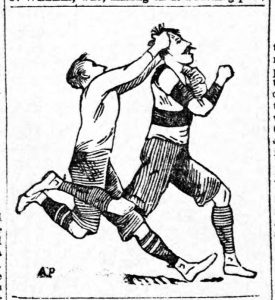
The start of the 1897-98 season saw Harries play for the 2nds against the Swansea Reserves as a season opener on 25th September. The 2nds won easily. As half-back for the ‘Reserves’ Frank Bevan would get to know Harries better, as his partner in the 2nds. Another notable name in the ‘Reserves’ that day was future ‘Great’ Billy Trew (captain of Swansea and Wales – 26 caps). It was the rugby genius’ Swansea club debut this day. As the season progressed Bevan and Harries became the preferred pairing, Eddie Evans’ star now waning.
More matches followed for Dai Harries; Rhondda side Treherbert were the visitors when Swansea’s future Welsh cap Dan Rees scored a hat trick in a 20 to nil demolition of the visitors. Harries got in on the try fest too: “D. Harris [sic] however, getting the ball from touch, scored a splendid try, which Hill converted.” Dai played in the 2nds side that beat rivals Llanelli before suffering a loss away to Briton Ferry, Harries again getting Swansea’s only try. Another win over Aberavon was tempered with defeat at Cardiff Arms Park to Cardiff 2nds. But the Swansea 2nds were a strong side this season and registered consecutive wins over Newport (home) and Llanelli (away), Harries scoring a fine try in the latter match at Stradey Park: “From a scrum here Harries got over with a fine try, which was not converted.” Llandovery College (home) and Neath (home) were defeated before a tough draw was fought with Llandeilo, a side who had provided the Swansea 1st XV with several good players including George Davies, his brother Jack, Livingstone Davies, Frank and Wally Fuller. By now Harries and Bevan were working together well as just 3 losses all season illustrated.
Dai Harries makes his first fifteen debut.
This form saw Harries selected to the 1st XV along with Bevan, to face Neath’s senior team away on 8th January 1898. The match was played on the Bird-in-Hand Field (where the modern Civic Centre stands) in Neath, they having temporarily lost their tenancy of the Gnoll ground. With Swansea missing their captain and talisman Billy Bancroft as well as the experienced James brothers, Neath scented a chance to turn Swansea over and narrowly did so by 2 converted tries and a try to 1 converted try and 2 tries (13 – 11). D J Harries’ near namesake in the Swansea pack, David Harris left the field in the first-half with 2 broken ribs, leaving Swansea to finish the match with 14 men. But Harries and Frank Bevan worked hard to get the Swansea three-quarters into the game and 3 Swansea tries resulted, yet Neath pipped it with the extra conversion. Despite the absence of David and Evan James, The Post felt that the Swansea halves: “Bevan and Harris [sic] were two excellent substitutes, and were looked upon as quite the equals of the Neath pair.” It was a tough initiation for Harries in a local derby where much civic pride was at stake.
‘Flying Dai’ tours with the first fifteen.
Harries played in 2 further wins for the 2nd XV against Cardiff 2nd XV and the Mumbles club of Swansea. But he got another chance to turn out for the senior team when they embarked on their second rugby tour of the season, a short trip to the West Country in March. Evan James was now fit again but his older brother David was not, though he did travel with the party. Swansea 2nd XV skipper Eddie Evans’ form had noticeably dropped and the club committee selected Dai Harries on the strength of his performance under pressure in the Neath game, to join the 1st XV on tour. He broke into the ‘seniors’ on merit as the South Wales Daily Post remarked: “D.J. Harries is Swansea’s best reserve half. Eddie Evans has certainly fallen off greatly.”
The ‘All Whites’ travelled by ferry across the Bristol Channel to Ilfracombe and then on westward. The first match was against Devonport Albion at the Rectory Field ground on 26th March 1898. Devonport were traditionally a tough opponent for Swansea and fielded a fearsome pack of forwards. Billy Bancroft’s well-known aversion to travel by boat plagued him still and he was too ill from the crossing to play in this match, his understudy Dai Austin turning out at full-back for Swansea. Dai Harries partnered Evan James, but their regular positions were swapped, with James unaccustomedly at outside-half. The innovation did not pay off and James was unable to marshal the three-quarter line as his brother David could, Harries struggling to get fast ball to James from the base of the scrum.
A crowd of 10,000 saw Swansea lose the match 8 – 0, their 6th and last defeat of the season. Dai Harries’ performance was criticised in comparison to David James’ sublime game, when fit, a harsh judgement considering his having been placed at scrum-half and that the James brothers had played together since they were children. The South Wales Echo however, felt the Swansea halves had outplayed their opposing halves, though James and Harries’ play together “was somewhat ragged, and the passing very faulty at times.”
Bristol v Swansea. Dai Harries records a win with the ‘seniors’.
On 28th the short tour was wrapped up with a match against Bristol at the County Ground. The Swansea team was unaltered except that Arthur Jones replaced the newly capped Hopkin Davies in the pack as Davies was rested ahead of his second Welsh cap (against England on 2nd April). So Dai Harries again partnered Evan James behind the scrum. Again he was placed at scrum-half. The Bristol side were reinforced with a couple of players from the strong Gloucester and Clifton clubs. The Bristol Mercury commented on the swiftness of the passing of the Swansea backs. Clearly they were getting used to each other now and they were able to get their talented runners the ball with the time and space to do damage.
First Dan Rees and later Billy Trew crossed for Swansea, Dai Austen converting one try to a goal. Swansea won the match by a goal and try to a try (8 – 3) and D J Harries had registered a win with the ‘All Whites’ senior side and played his part alongside such greats as Evan James, Billy Trew, George Davies, Dan Rees, Will Parker, Tom Jackson and Bob Thomas, all capped or future caps with Wales. Wing Frank Gordon would go on to captain Swansea for 4 seasons, including the Invincible’ season of 1904-05. Billy Bancroft continued to amass his record breaking run of Welsh caps, culminating in 1901 with a 33rd consecutive appearance for Wales. Swansea went on to regain the Welsh Championship the following season. This was the start of their first ‘Golden Era’ when they were Champions 6 seasons out of 7 and were unrivalled by any team in Britain.
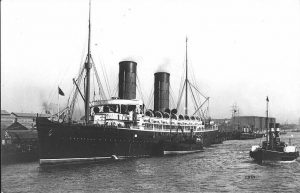
The New World calls. Work opportunities draw Harries to the USA.
But what of D J ‘Dai’ Harries? A news article on 29th September 1898 declared: “D.J. Harries, who with young Bevan acted as substitutes for the Jameses on several occasions, goes to America on Friday [30th].” And so he did, sailing on 1st October 1898 aboard the RMS Campania of the Cunard Shipping Line, bound for Pittsburgh where he stayed initially with his brother-in-law. The depression in the steel trade in Britain was increasingly forcing closures and, with the American Steel industry approaching its boom years, many steel workers from Wales took the great gamble and travelled to build a new life in the USA. Dai Harries travelled together with a friend Anthony Thomas, both listed as travelling from Landore on the ship’s passenger list. They arrived in New York on 8th October, Dai travelling on to Pittsburgh, where the 1900 census has him living there with his aunt and uncle.
Dai Harries moved on to Steubenville, Ohio where he is registered as living in the 1910 census, employed as a steel worker. He was married in 1905 to Mary Ann Lloyd, another Welsh émigré and had five children.
But that was not the end of the tale, for he did sail back to Wales sometime after the 1900 census, returning finally to the USA in 1903, this time aboard the RMS Teutonic of the White Star Line. Exactly why he returned is not clear, but the family story passed down was that he had returned to tell a girl he was to have married that it was not to be.
No rugby on Sundays for Dai!
Another story passed down among his family about ‘flying Dai’ was that his mother put a stop to his playing for Swansea because she disapproved of them having played on a Sunday! This reference was to Swansea’s historic tour (the first Welsh side to play abroad) to Paris in April 1899. Dai Harries would of course have been in Pittsburgh at this time. But the Swansea match arranged against a Stade Français team became a match against a Combined French XV, due to the Frenchmen’s apprehension about taking on the new Welsh Champions. And it was played on SUNDAY 16th April at the Bécon-les-Bruyères ground in Paris. Swansea won by 30 points to 3, but on returning home, the club faced a storm of indignation for having played the match on a Sunday. So much so that a Welsh Union directive was issued to forbid any Welsh teams doing so in future. So although the fixture was maintained, they dared not play it on a Sunday in future.
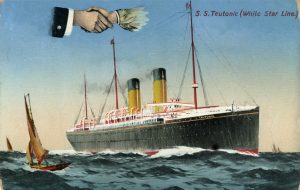
All this was played out in the local newspapers and Dai Harries’ mother would have been well aware of the depth of feeling in some parts of the town about the club’s perceived transgression. Objecting as she did to football on Sundays, she would surely have let her feelings be known to the returning son. Dai may have played one more match for Swansea seconds during his sojourn there. This is partially supported by an Evening Express report that has him playing once for Swansea 2nds as a ‘centre’ on 17th February 1900 at home to Newport 2nd XV. As his full initials are used, this may be so. If he did, his mother’s stance on the morality of Sunday matches would have precluded any further such activity and he is not recorded as turning out for the ‘All Whites’ again. He sailed back for the last time from Liverpool on 9th November 1903.
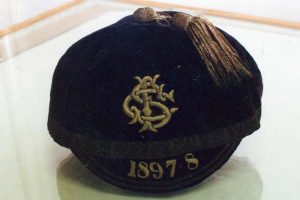
But he had won his Swansea cap. Dai Harries worked as a Steelman in Steubenville, Ohio, raised a family there and passed away aged 90 years on 16th May 1965. As an elderly man Dai shared many stories with his family but the connection with Swansea RFC faded from the family’s memory until that navy blue tasselled cap shown to his grandson Marc Harris, began enquiries, aided by WRU stalwart Peter Owens, who pointed them to Swansea RFC and a path that uncovered the hitherto unknown activities of D J ‘flying Dai’ Harries with the famous ‘All Whites’ of Swansea.
Article compiled by Dave Dow (Swansea RFC Archives) with grateful thanks to the Harris family in West Virginia, USA.

